|
< Earlier Kibitzing · PAGE 3 OF 3 ·
Later Kibitzing> |
| Jul-04-08 | | Once: <Polish Pentium> 39. Qxd5 Rxh2+ 40. Kxh2 41. exd5 and it's four pawns against two. Black will advance his king to f6 and the white f5 pawn is doomed. White cannot protect it because e4 and f4 are controlled by black pawns and putting his king on g4 does nothing to hold back the passed d pawn. Black also would have ideas of h5 to kick the white king away. For that matter, 39. Qxd5 exd5 40. Kxg2 also wins for black for much the same reason. Now it's only four pawns against three but the black f5 pawn is not long for this world and the passed d pawn is a monster. |
|
| Aug-01-11 | | Eduardo Bermudez: the final blow is very strong !! |
|
| Dec-28-16 | | clement41: Superb tactical blow! |
|
Dec-29-16
 | | Phony Benoni: 38...Rxh2+ is probably right, but I'm too tired to push the rook that far. Maybe we can make do with <38...Rg2> instead, with fork if White takes and mate if White doesn't. |
|
| Dec-29-16 | | nalinw: I saw many of the ideas around the fork - but not THE idea of mate in 3! |
|
| Dec-29-16 | | Fish55: Pretty. I finally saw it after realizing that neither Nf4+ or g4+ did the trick. |
|
| Dec-29-16 | | ozmikey: Not all that difficult once you're told it's there, but an unusual idea which I'm sure I'd completely miss in a game situation! |
|
| Dec-29-16 | | Cheapo by the Dozen: The most intriguing ideas involve ... Nf4 and ... Rg2, with a shot at a mating net. Unfortunately, in most lines White's king can escape toward the queenside. However, there's no defense to an immediate 38 ... Rg2 other than eliminating one or more of the mating pieces. OK, then -- let's consider: 38 ... Rg2
39 Qxd5 exd5
40 Kxg2
That doesn't look so great for Black -- but wait! There's a Zwischenzug possibility: 38 ... Rg2
39 Qxd5 Rxh2+
40 Kxh2 exd5
41 Kg3 h5
White is well and truly busted. |
|
| Dec-29-16 | | ChessHigherCat: I played through the game and was really proud of guessing all of white's moves, thinking "That's exactly the same great move that I would have played!", but then I realized that I would have lost exactly like he did! |
|
| Dec-29-16 | | agb2002: Black has a rook, a knight and a pawn for the queen. White threatens fxe6.
Black can create a mate net with 38... Rg2:
A) 39.Kxg2 Ne3+ and 40... Nxd1 wins.
B) 39.Qxd5 Rxh2+ 40.Kxh2 exd5 - + [2P].
C) 39.Qf3 Nf4+ 40.Qxf4 gxf4 (40... Rxh2+ 41.Qxh2 + -) 41.Kxg2 exf5 42.Kf3 Kf7 43.Kxf4 Kf6 wins. For example, 44.Kf3 Ke5 45.Ke3 f4+ 46.Kf3 Kf5 47.Kf2 Ke4 48.Ke2 Kd4 49.Kd2 b4 50.h3 f3 51.h4 f2 52.Ke2 Kc3 53.Kxf2 Kb2, etc. D) 39.fxe6 Nf4#. |
|
| Dec-29-16 | | YouRang: Thursday 38...?
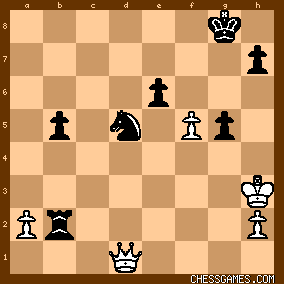
click for larger view
I guessed pretty quickly (and correctly) that this had to be some sort of tactic to fork white's K+Q. Our Nd5 can already attack the white Q, but to make the fork work we need to entice the king to g4 or g2. I first considered 38...g4+, hoping for 39.Kxg4?? Ne3+ -- but of course 39.Qxg4 wins for white, so phhft. Next I considered <38...Rg2!>

click for larger view
This is rather pretty. The rook is immune (39.Kxg2 Ne3+ and ...Nxd1  ) AND we threaten checkmate (...Nf4#). A quick review of white's options are bleak: White's must lose his queen to either a fork or to prevent mate. ) AND we threaten checkmate (...Nf4#). A quick review of white's options are bleak: White's must lose his queen to either a fork or to prevent mate. White can't do much better than <39.Qxd5 exd5 40.Kxg2>

click for larger view
Black plays 40...h5 and then has no trouble taking Pf5 and winning the pawn ending. |
|
| Dec-29-16 | | TheBish: J M Bellon Lopez vs G Garcia, 1976 Black to play (38...?) "Medium"
Material is actually even, but it seems that Black must be better, with either a mating net or win of the queen looming. My first candidate move was the obvious 38...Nf4+, which leaves Black wanting, as there is no mate and no win of the queen. I then saw 38...h5!?, seemingly building a net, with the nifty point 39. Qxh5?? Nf4+. But this is much easier to solve if you give Black two moves in a row (one can dream), and then it falls into place, especially after looking for knight forks. 38...♖g2! and Black wins the queen after 39. ♔xg2 ♘e3+, so White is forced to enter a losing "pawn war" after either 39. ♕xd5 exd5 40. ♔xg2 ♔f7 or 39. ♕f1 ♘f4+ 40. ♕xf4 gxf4 41. ♔xg2 e5. Nice finish! |
|
| Dec-29-16 | | The Kings Domain: Good puzzle and good game, bold queen sacrifice by black. |
|
| Dec-29-16 | | Sularus: somehow the motif of forking came naturally to me today. |
|
| Dec-29-16 | | varishnakov: This is much easier than yesterday's. Yesterday's puzzle, with best play, was more difficult than its game continuation, and we had to work through many lines to get the answer. Here there are no long variations---
38...R-N7 threatens 39...N-B5 mate
39.KxR N-K6+ wins the queen
39.QxN PxQ 40.KxR material is more even than the previous line, but the king and pawn endgame is completely lost for white. |
|
| Dec-29-16 | | devere: Easy puzzle for a Thursday. Beautiful positional queen sacrifice by Black. The Black knight on d5 is the rock of Gibralter, and White can do nothing. It's hard to think about just getting a draw when you have queen for bishop+knight+2pawns, but that's what White should have done. 32.Kh3 was likely the losing mistake. |
|
| Dec-29-16 | | YouRang: Stepping back a few moves, one has to appreciate how efficiently black makes use of all his material. Consider the position after <32.Kh3>

click for larger view
Black puts deadly threats into motion with <32...g5!>

click for larger view
The immediate threat of ...Rc3! would be easily overlooked by mere mortals. For instance, suppose 33.Ra7? Rc3! 34.Qf2 Nf4! (note the pin on Pg4) 35.Kg4 h5#! To his credit, white did see this threat and he played the only game-saving move: <33.Ra3!>. However, mate threats are still in the air. Black now plays <33...Be7!>

click for larger view
Besides the obvious threat on Ra3, black threatens ...f5, e.g. if 34.Rd3? f5! 35.Rd4 (must prevent deadly ...g4+) 35.Rd4 Bf6, leaving white with no escape squares for the rook on the 4th rank. White replies with <34.Qd1> attacking the annoying rook (34.Qe4 would have been better as it allows for a game-evening offensive, e.g. 34...Rb2 35.Ra8+ Kg2 36.Qe5+ Bf6 37.Qb8! threatening Qg7+)
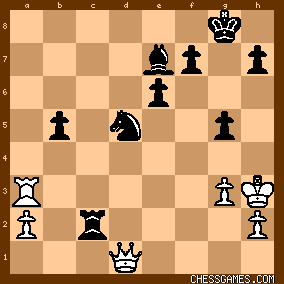
click for larger view
Black answers <32...Rb2!>, getting rook out of take while maintaining threat on Ra3. More importantly, white can't continue to attack black's rook because ...Bxa3 will protect it. Again, white found the best move: <35.Ra7>, attacking the DSB which supports black's mating threats. Other moves lose for very subtle reasons (e.g. 35.Ra8+ Kg7 36.Ra7 may seem just as good, but it loses because the 8th rank check has been wasted -- white will wish he had it later on.)

click for larger view
Black proceeds with the threat enabled by 33...Be7, namely <35...f5!>. This threatens ...g4+ which loses on the spot. White must surrender the exchange to diffuse it: <36.Rxe7 Nxe7>

click for larger view
This is where white finally blundered (perhaps relaxing a bit thinking that the mate threats were gone). He played <37.g4?>, since the "natural" replies (...fxg4 or ...f4) can be answered favorably for white. He should have first played 37.Qd8+! Kf7 and then 38.g4, as this gets the queen into position to give check and steal pawns and get out of knight forking range. Black saw that this blunder provided gave him a winning game despite the limited material: <37...Nd5!>, creating all sorts of winning shots thanks to the queen forking threats. For example, ...fxg4+ Kg3 (Kxg4? ...Ne3+  ) ...Rg2+! Kf3 (Kxg2? ...Ne3+ ) ...Rg2+! Kf3 (Kxg2? ...Ne3+  ), etc. ), etc. White evidently saw the ...fxg4 threate and thought it was resolved with <38.gxf5>, but of course it didn't because besides the queen-forking threats, it carried the mating threat with ...Nf4, which is sprung with the puzzle solution: <38...Rg2!> Very high-level chess by both players, showing how hard it can be to dodge all the subtle threats all of the time. |
|
| Dec-29-16 | | catlover: <You Rang> Thanks. Your comments on the moves leading up to the puzzle position are very helpful. |
|
| Dec-29-16 | | Gilmoy: Typing before reading :) Yesterday(?) this game was link-cited for the lovely Rg2 idea, so I "knew" the solution. Assume White sees that, too (and doesn't die first of a broken heart :( ), and we notice that White can sell Q for R+N, which almost saves it. So that's the puzzle-after-the-puzzle, a loose end that is a key part of the proof. 38..Rg2 39.Q<sees-f4, e.g. Qf1> Nf4+ <Black sees it, too> 40.Qxf4 gxf4 41.Kxg2 <yes but> e5! 
click for larger viewThe <shield pair> wins: White's K can never go to 5. a/b and h/h are non-passed Nim pairs, and Black's K is in the f5-box. In fact, Black's K easily eats f5, since he has two squares from which to attack it (f6/g5), while White has only f4 to guard it once (and cannot go to d5 to counter-threaten e5), so Black can zug White out of f4. Thereafter, Black's K can roam the entire board at will. White's longest defense probably is to shuffle his K around f3 while Black's K eats the a-pawn and queens at b1. 41..exf5?? might be only a draw. Let your apples ripen! |
|
Dec-29-16
 | | Fusilli: <YouRang> I agree with <catlover>, your comments are always engaging. (I'd like to extend this compliment to <Jimfromprovidence> as well.) On a minor note, when you describe the threat after 37...Nd5!: <For example, ...fxg4+ Kg3 (Kxg4? ...Ne3+ ) ...Rg2+! Kf3 (Kxg2? ...Ne3+ ), etc.> Kf3 is an illegal move because of the black pawn on g4. Kxg2 is the only legal move there. |
|
Dec-29-16
 | | Jimfromprovidence: Just looking at the puzzle position, I did not remember posting about this match as the game of the day from just about 8 1/2 years ago. It was and still is a lot of fun to play through. OK, since the text 38 gxf5 obviously loses, it seems that here should be a better move for white. What about 38 Qh1!?, safe from knight forks and possibly a fortress position? 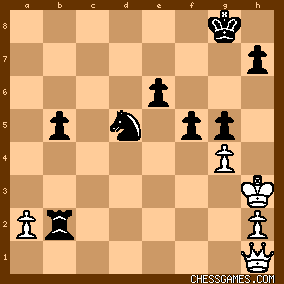
click for larger view |
|
| Dec-29-16 | | devere: According to Stockfish White could have kept equality with 34.Qe4 (instead of Qd1) Rb2 35.Ra8+ Kg7 36.Qe5+ Bf6 37.Qb8 Kg6 38.g4 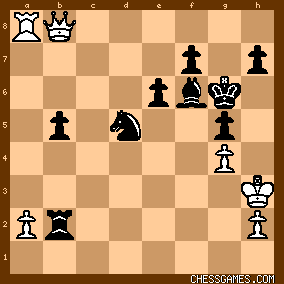
click for larger view |
|
| Dec-29-16 | | YouRang: <catlover>, <Fusilli> thanks for the remarks, and also the correction. Indeed after ...fxg4+, white can't escape the fork. |
|
| Dec-29-16 | | YouRang: <Jimfromprovidence><OK, since the text 38 gxf5 obviously loses, it seems that here should be a better move for white. What about 38 Qh1!?, safe from knight forks and possibly a fortress position?> It looks like 38.Qh1 may be white's best choice, but it still loses after <38...Nf4+ 39.Kg3 Rg2!>

click for larger view
Now, <40.Kf3 fxg4+ 41.Ke4 h5!>
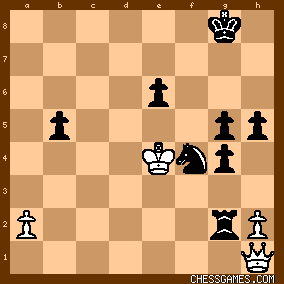
click for larger view
What's happening here is that black is beginning the crushing pawn storm with some assistance from pieces, while white's most powerful weapon is stuck in a corner with limited mobility, defending a pawn. However, that's not to say that black can relax. If say <42.Qd1>:

click for larger view
Black had best not play 42...Rxh2? 43.Qd8! leads to a perpetual check. Black's best is push the white king onto the d-file with <42...Re2+! 43.Kd4> the king is blocking his own queen, which now allows <43...Rxh2>
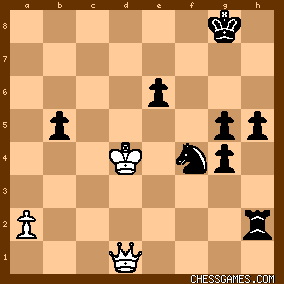
click for larger view
White can still try <44.Ke5>

click for larger view
White is still hoping for perpetual check, and black must be very careful to avoid it. The only correct move is <44...Kg7!> because after <45.Qd7+ Kh6!>, white cannot give check or threaten mate (if black had blundered with 44...Kh7?, white has 45.Kf6! and now black will have to scramble to *salvage* the draw).
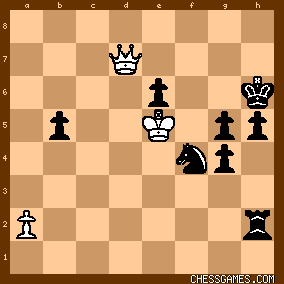
click for larger view
Now white can try to attack, say <46.Kf6>, but <46...Nd5+ 47.Kxe6 Re2+> leaves
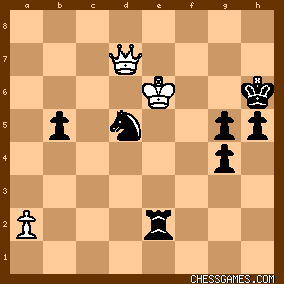
click for larger view
Of course 48.Kxe5 Rd2+ loses. More likely, 48.Kf5 Rf2+ 49.Ke5 Nf6, and black is in position to defend his king and push his pawns, and white is finally in position to resign. |
|
| Mar-22-22 | | Mathematicar: Beautiful final blow. Pushing g pawn doesn't work because white king can escape to g5 without fear. |
|
 |
 |
|
< Earlier Kibitzing · PAGE 3 OF 3 ·
Later Kibitzing> |





